Curing your handmade lye soap starts with a critical two-week hardening phase, followed by a standard four-week period for ideal quality. For premium results, you'll want to extend curing to six weeks, while specialty oil blends need eight weeks to mature properly. If you're making true Castile soap with pure olive oil, plan on twelve weeks of aging time. Understanding these distinct curing phases can transform your soap-making success.
The Essential Two-Week Initial Hardening Phase
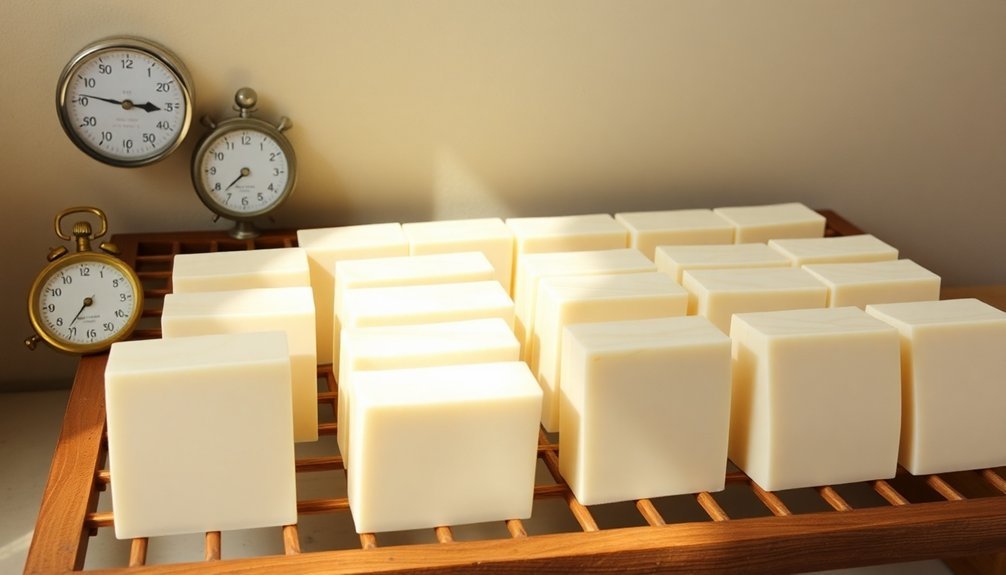
The first two weeks of curing handmade lye soap bars represent the most critical phase in your soap-making journey.
During this initial hardening phase, you'll notice significant water evaporation that transforms your bars from soft to firm. It's important to place your soap bars in a cool, dry place with proper air circulation to guarantee ideal curing conditions.
You'll want to pay close attention to how your bars develop during this curing time. By monitoring weight changes, you can track the reduction of excess moisture, which directly affects the final quality of your handmade lye bars.
This process helps prevent your soap from becoming too soft and dissolving quickly during use. Remember, proper hardening during these first two weeks sets the foundation for durable, long-lasting bars.
Optimal Four-Week Standard Curing Period
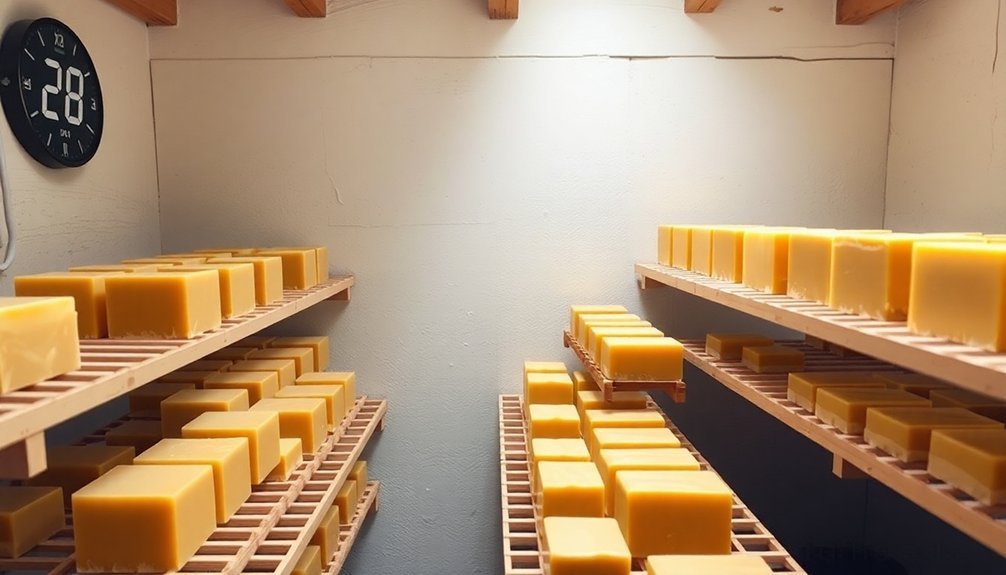
While two weeks marks the initial hardening phase, extending your soap's curing time to four weeks delivers superior results across multiple qualities.
This ideal curing period guarantees your handmade lye soap reaches its full potential by allowing excess moisture to evaporate completely, making your bars harder and longer-lasting.
You'll notice significant improvements in your soap's performance during this four-week period.
The lye becomes fully neutralized, reducing the risk of skin irritation, while moisturizing properties develop to their fullest.
Your soap's lather will become richer and creamier, creating a more luxurious washing experience.
As an added benefit, you'll discover that scents mature beautifully during this time, resulting in more pronounced and balanced fragrances in your finished bars.
Extended Six-Week Aging for Premium Results
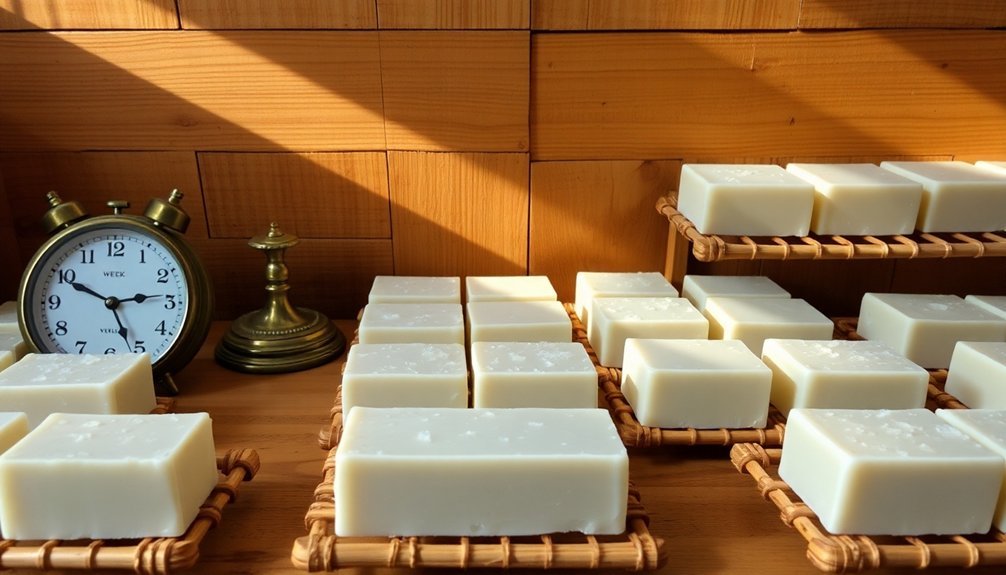
For those seeking exceptional quality in their handmade soap, extending the curing period to six weeks yields premium results that surpass standard curing times.
During this extended cure time, you'll notice your cold process soap undergoes significant improvements that benefit both soap makers and users alike.
The six-week aging process allows moisture to evaporate fully, creating a harder bar that'll last longer in your shower.
You'll find the extended curing period enhances lather quality while ensuring all lye is completely neutralized, eliminating risks of skin irritation.
As an added benefit, you'll experience a more pronounced fragrance in your handmade soap.
When properly cured, your bars should feel firm and produce a rich, creamy lather that demonstrates the superior quality achieved through patience and proper aging.
Eight-Week Maturation for Specialty Oil Blends
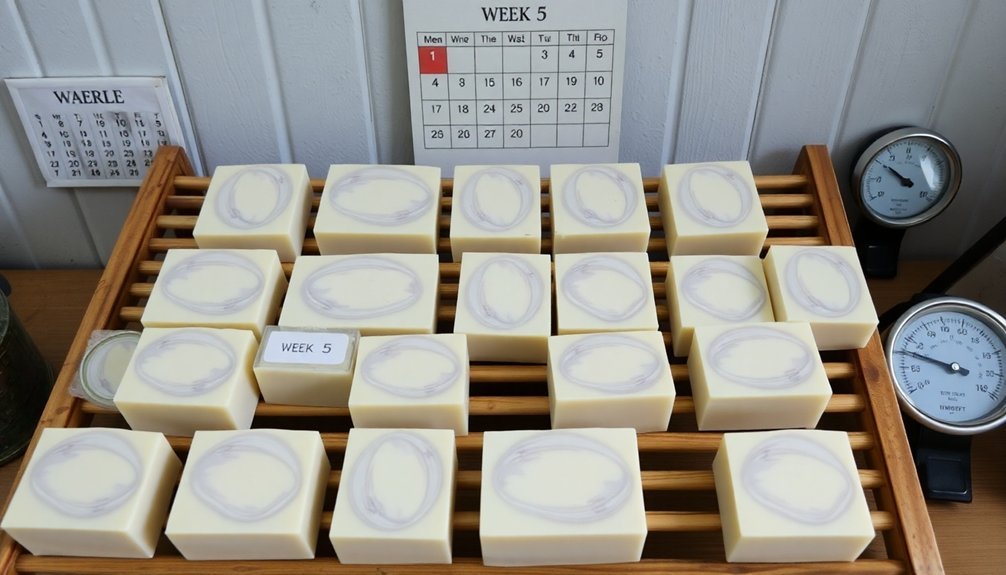
Specialty oil blends demand even more patience than standard soap formulations, extending beyond the six-week mark to achieve their full capacity.
You'll find that an eight-week maturation period is essential when working with high-percentage olive oil or butter-based soaps.
During this extended curing time, you're allowing the saponification process to complete fully, ensuring your soap is skin safe as all lye neutralizes.
Proper curing isn't just about drying – it's a crucial safety step that allows lye to fully neutralize, making your soap gentle and safe.
You'll notice excess moisture evaporating throughout these eight weeks, which dramatically improves your soap's performance and lather quality.
The fragrance in specialty oil blends often becomes more prominent during this period, enhancing the overall experience.
To achieve ideal results, you'll need to maintain a consistent curing environment between 60°F to 80°F with proper air circulation throughout the maturation process.
Traditional Twelve-Week Aging for Castile Soaps
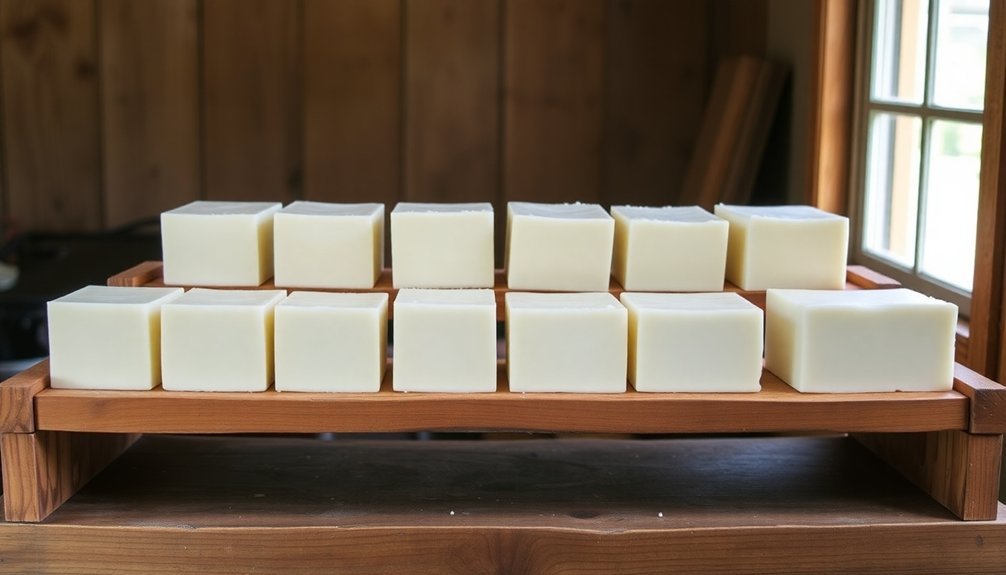
True Castile soaps, crafted exclusively with olive oil, need a considerably longer maturation period of twelve weeks to reach their peak quality.
During this extended curing time, you'll notice significant improvements as proper saponification occurs and excess moisture evaporates from your handmade lye bars.
You'll find that the aging period enhances your Castile soap's characteristics in multiple ways. The lather becomes richer and creamier, while the soap's color may deepen naturally.
You'll also notice that the fragrance develops more fully as the soap matures. To guarantee ideal results, you'll need to maintain proper storage conditions throughout the twelve weeks.
Keep your soaps in a cool, dark area with good air circulation to prevent mold and maximize quality development.
Frequently Asked Questions
How Long Should Lye Soap Cure?
You'll need to cure your lye soap for 4-6 weeks minimum to guarantee it's safe and effective. If you're patient, letting it cure for up to 12 weeks will give you better lather and gentler results.
How Do You Know When Homemade Soap Is Cured?
You'll know your homemade soap is cured when it's hard to the touch, shows no moisture or stickiness, and creates a rich, creamy lather. The color may deepen, and it'll reach ideal quality after 4-6 weeks.
How Long to Let Soap Cure Before Cutting?
You'll need to wait at least 24-48 hours before cutting your homemade soap. Make sure it's completely cooled and firm to the touch. Don't rush this step, or you'll end up with crumbly bars.
How to Cure Homemade Soap Faster?
You'll speed up soap curing by using less water in your recipe, cutting thinner bars, and placing them in a well-ventilated area with a fan. Try CPOP method and monitor humidity levels for ideal results.
In Summary
You'll find that patience truly pays off when curing your handmade lye soaps. While two weeks is your minimum wait time, extending the cure to 4-12 weeks dramatically improves your soap's quality. Choose your curing time based on your recipe – standard bars need 4 weeks, specialty blends require 8 weeks, and pure castile soaps benefit from a full 12-week cure. Your bars will be harder, milder, and longer-lasting.





Leave a Reply